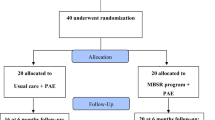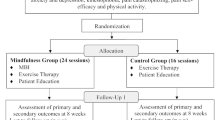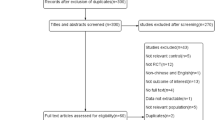Abstract
Tai Chi mind–body exercise is widely believed to improve mindfulness through incorporating meditative states into physical movements. A growing number of studies indicate that Tai Chi may improve health in knee osteoarthritis (OA), a chronic pain disease and a primary cause of global disability. However, little is known about the contribution of mindfulness to treatment effect of Tai Chi practice. Therefore, our purpose was to investigate the effect of Tai Chi mind–body practice compared to physical therapy (PT) on mindfulness in knee OA. Adults with radiographic-confirmed, symptomatic knee OA were randomized to 12 weeks (twice weekly) of either Tai Chi or PT. Participants completed the Five Facet Mindfulness Questionnaire (FFMQ) before and after intervention along with commonly used patient-reported outcomes for pain, physical function, and other health-related outcomes. Among 86 participants (74% female, 48% white, mean age 60 years, 85% at least college educated), mean total FFMQ was 142 ± 17. Despite substantial improvements in pain, function, and other health-related outcomes, each treatment group’s total FFMQ did not significantly change from baseline (Tai Chi = 0.76, 95% CI −2.93, 4.45; PT = 1.80, 95% CI −2.33, 5.93). The difference in total FFMQ between Tai Chi and PT was not significant (−1.04 points, 95% CI −6.48, 4.39). Mindfulness did not change after Tai Chi or PT intervention in knee OA, which suggests that Tai Chi may not improve health in knee OA through cultivating mindfulness. Further study is needed to identify underlying mechanisms of effective mind–body interventions among people with knee OA.

Similar content being viewed by others
References
Baer, R. A., Smith, G. T., Lykins, E., Button, D., Krietemeyer, J., Sauer, S., et al. (2008). Construct validity of the five facet mindfulness questionnaire in meditating and nonmeditating samples. Assessment, 15(3), 329–342. doi:10.1177/1073191107313003.
Bawa, F. L. M., Mercer, S. W., Atherton, R. J., Clague, F., Keen, A., Scott, N. W., & Bond, C. M. (2015). Does mindfulness improve outcomes in patients with chronic pain? Systematic review and meta-analysis. The British Journal of General Practice, 65(635), e387–e400. doi:10.3399/bjgp15X685297.
Bellamy, N., Buchanan, W. W., Goldsmith, C. H., Campbell, J., & Stitt, L. W. (1988). Validation study of WOMAC: A health status instrument for measuring clinically important patient relevant outcomes to antirheumatic drug therapy in patients with osteoarthritis of the hip or knee. The Journal of Rheumatology, 15(12), 1833–1840 Retrieved from http://www.ncbi.nlm.nih.gov/pubmed/3068365.
Bergomi, C., Tschacher, W., & Kupper, Z. (2013). The assessment of mindfulness with self-report measures: existing scales and open issues. Mindfulness, 4(3), 191–202. doi:10.1007/s12671-012-0110-9.
Brady, T. J. (2011). Measures of self-efficacy: arthritis self-efficacy scale (ASES), arthritis self-efficacy scale-8 item (ASES-8), children’s arthritis self-efficacy scale (CASE), chronic disease self-efficacy scale (CDSES), parent’s arthritis self-efficacy scale (PASE), an. Arthritis Care & Research, 63 Suppl 1, S473–S485. doi:10.1002/acr.20567.
Caldwell, K., Emery, L., Harrison, M., & Greeson, J. (2011). Changes in mindfulness, well-being, and sleep quality in college students through taijiquan courses: A cohort control study. Journal of Alternative and Complementary Medicine (New York, N.Y.), 17(10), 931–938. doi:10.1089/acm.2010.0645.
Chen, Y.-W., Hunt, M. A., Campbell, K. L., Peill, K., & Reid, W. D. (2015). The effect of tai Chi on four chronic conditions-cancer, osteoarthritis, heart failure and chronic obstructive pulmonary disease: A systematic review and meta-analyses. British Journal of Sports Medicine. doi:10.1136/bjsports-2014-094388.
Christopher, M. S., Rogers, B., Hunsinger, M., Colgan, D., Reiss, A. L., & Farwood, H. B. (2015). Distinguishing mindful process from outcome in the prediction of Global Health and perceived stress in a mindfulness-based stress reduction program. Mindfulness, 6(4), 693–699. doi:10.1007/s12671-014-0305-3.
Delgado, R., York, A., Lee, C., Crawford, C., Buckenmaier 3rd, C., Schoomaker, E., & Crawford, P. (2014). Assessing the quality, efficacy, and effectiveness of the current evidence base of active self-care complementary and integrative medicine therapies for the management of chronic pain: A rapid evidence assessment of the literature. Pain Medicine (Malden, Mass.), 15 Suppl 1, S9–20. doi:10.1111/pme.12412.
Deyle, G. D., Allison, S. C., Matekel, R. L., Ryder, M. G., Stang, J. M., Gohdes, D. D., et al. (2005). Physical therapy treatment effectiveness for osteoarthritis of the knee: A randomized comparison of supervised clinical exercise and manual therapy procedures versus a home exercise program. Physical Therapy, 85(12), 1301–1317.
Fransen, M., Mcconnell, S., Harmer, A. R., Van der Esch, M., Simic, M., & Bennell, K. L. (2015). Exercise for osteoarthritis of the knee. The Cochrane Database of Systematic Reviews, (1), CD004376. doi:10.1002/14651858.CD004376.pub3.
Gould, L. F., Mendelson, T., Dariotis, J. K., Ancona, M., Smith, A. S. R., Gonzalez, A. A., et al. (2014). Assessing fidelity of core components in a mindfulness and yoga intervention for urban youth: Applying the CORE process. New Directions for Youth Development, 2014(142), 59–81. doi:10.1002/yd.20097.
Gu, J., Strauss, C., Bond, R., & Cavanagh, K. (2015). How do mindfulness-based cognitive therapy and mindfulness-based stress reduction improve mental health and wellbeing? A systematic review and meta-analysis of mediation studies. Clinical Psychology Review, 37, 1–12. doi:10.1016/j.cpr.2015.01.006.
Holzel, B. K., Lazar, S. W., Gard, T., Schuman-Olivier, Z., Vago, D. R., & Ott, U. (2011). How does mindfulness meditation work? Proposing mechanisms of action from a conceptual and neural perspective. Perspectives on Psychological Science, 6(6), 537–559. doi:10.1177/1745691611419671.
Kabat-Zinn, J. (2015). Meditation—it’s not what you think. Mindfulness, 6(2), 393–395. doi:10.1007/s12671-015-0393-8.
Kabat-zinn, J., Lipworth, L., & Burney, R. (1985). The clinical use of mindfulness meditation for the self-regulation of chronic pain. Journal of Behavioral Medicine, 8(2), 163–190.
Kelley, G. A., & Kelley, K. S. (2015). Meditative movement therapies and health-related quality-of-life in adults: A systematic review of meta-analyses. PloS One, 10(6), e0129181. doi:10.1371/journal.pone.0129181.
Kraus, V. B., Blanco, F. J., Englund, M., Karsdal, M. A., & Lohmander, L. S. (2015). Call for standardized definitions of osteoarthritis and risk stratification for clinical trials and clinical use. Osteoarthritis and Cartilage, 23(8), 1233–1241. doi:10.1016/j.joca.2015.03.036.
Lange, K., Gorbunova, A., & Christ, O. (2012). The influence of mindfulness on different aspects of pain perception and affective reactivity to pain—feasibility of a multimethodical approach. Mindfulness, 3, 209–217. doi:10.1007/s12671-012-0113-6.
Larkey, L., Jahnke, R., Etnier, J., & Gonzalez, J. (2009). Meditative movement as a category of exercise: Implications for research. Journal of Physical Activity & Health, 6(2), 230–238.
Lee, C., Crawford, C., & Hickey, A. (2014). Mind–body therapies for the self-management of chronic pain symptoms and active self-care therapies for pain (PACT) working group. Pain Medicine, 15, S21–S39.
Ma, V. Y., Chan, L., & Carruthers, K. J. (2014). Incidence, prevalence, costs, and impact on disability of common conditions requiring rehabilitation in the United States: Stroke, spinal cord injury, traumatic brain injury, multiple sclerosis, osteoarthritis, rheumatoid arthritis, limb loss, and back pa. Archives of Physical Medicine and Rehabilitation, 95(5), 986–995.e1. doi:10.1016/j.apmr.2013.10.032.
Morone, N. E., & Greco, C. M. (2007). Mind–body interventions for chronic pain in older adults: A structured review. Pain Medicine, 8(4), 359–375. doi:10.1111/j.1526-4637.2007.00312.x.
Morone, N. E., Greco, C. M., & Weiner, D. K. (2008). Mindfulness meditation for the treatment of chronic low back pain in older adults: A randomized controlled pilot study. Pain, 134(3), 310–319. doi:10.1016/j.pain.2007.04.038.
Morone, N. E., Rollman, B. L., Moore, C. G., Li, Q., & Weiner, D. K. (2009). A mind–body program for older adults with chronic low back pain: Results of a pilot study. Pain Medicine (Malden, Mass.), 10(8), 1395–1407. doi:10.1111/j.1526-4637.2009.00746.x.
National Center for Complementary and Integrative Health. (2015). Spotlight on a modality: Tai Chi. Retrieved July 1, 2016, from https://nccih.nih.gov/health/providers/digest/taichi.
Nedeljkovic, M., Wirtz, P., & Ausfeld-Hafter, B. (2012). Effects of Taiji practice on mindfulness and self-compassion in healthy participants—A randomized controlled trial. Mindfulness, 3(3), 200–208. doi:10.1007/s12671-012-0092-7.
Nordin, M., & Nordin, S. (2013). Psychometric evaluation and normative data of the Swedish version of the 10-item perceived stress scale. Scandinavian Journal of Psychology, 54(1996), 502–507. doi:10.1111/sjop.12071.
Olsson, L., & Swedberg, K. (2005). Six minute walk test. European Heart Journal, 26(20), 2209–2209. doi:10.1093/eurheartj/ehi452.
Park, T., Reilly-Spong, M., & Gross, C. R. (2013). Mindfulness: A systematic review of instruments to measure an emergent patient-reported outcome (PRO). Quality of Life Research, 22(10), 2639–2659. doi:10.1007/s11136-013-0395-8.
Petersen, M., & la Cour, P. (2016). Mindfulness—what works for whom? Referral, feasibility, and user perspectives regarding patients with mixed chronic pain. Journal of Alternative and Complementary Medicine (New York, N.Y.), 22(4), 298–305. doi:10.1089/acm.2015.0310.
Phillips, K., & Clauw, D. J. (2011). Central pain mechanisms in chronic pain states—maybe it is all in their head. Best Practice & Research. Clinical Rheumatology, 25(2), 141–154. doi:10.1016/j.berh.2011.02.005.
Posadzki, P., & Jacques, S. (2009). Tai Chi and meditation. Journal of Holistic Nursing, 27(2), 103–114. doi:10.1177/0898010108330807.
R Development Core Team. (2012). R: A language and environment for statistical computing. Vienna, Austria: R Foundation for Statistical Computing.
Schmidt, S., Grossman, P., Schwarzer, B., Jena, S., Naumann, J., & Walach, H. (2011). Treating fibromyalgia with mindfulness-based stress reduction: Results from a 3-armed randomized controlled trial. Pain, 152(2), 361–369. doi:10.1016/j.pain.2010.10.043.
Sharon, H., Maron-Katz, A., Ben Simon, E., Flusser, Y., Hendler, T., Tarrasch, R., & Brill, S. (2016). Mindfulness meditation modulates pain through endogenous opioids. The American Journal of Medicine. doi:10.1016/j.amjmed.2016.03.002.
Steer, R. A., Ball, R., Ranieri, W. F., & Beck, A. T. (1999). Dimensions of the Beck depression inventory-II in clinically depressed outpatients. Journal of Clinical Psychology, 55(1), 117–128.
Tsafou, K., Lacroix, J. P. W., Ee, R. V., Vinkers, C. D. W., & De Ridder, D. T. D. (2016). The relation of trait and state mindfulness with satisfaction and physical activity: A cross-sectional study in 305 Dutch participants. Journal of Health Psychology. doi:10.1177/1359105315624748.
Visted, E., Vollestad, J., Nielsen, M. B., & Nielsen, G. H. (2015). The impact of group-based mindfulness training on self-reported mindfulness: A systematic review and meta-analysis. Mindfulness, 6(3), 501–522. doi:10.1007/s12671-014-0283-5.
Wang, C. (2012). Role of Tai Chi in the treatment of rheumatologic diseases. Current Rheumatology Reports, 14(6), 598–603. doi:10.1007/s11926-012-0294-y.
Wang, C., Collet, J. P., & Lau, J. (2004). The effect of Tai Chi on health outcomes in patients with chronic conditions: A systematic review. Archives of Internal Medicine, 164(5), 493–501. doi:10.1001/archinte.164.5.493.
Wang, C., Iversen, M. D., McAlindon, T., Harvey, W. F., Wong, J. B., Fielding, R. A., et al. (2014). Assessing the comparative effectiveness of Tai Chi versus physical therapy for knee osteoarthritis: Design and rationale for a randomized trial. BMC Complementary and Alternative Medicine, 14(1), 333. doi:10.1186/1472-6882-14-333.
Wang, C., Schmid, C. H., Iversen, M. D., Harvey, W. F., Fielding, R. A., Driban, J. B., et al. (2016). Comparative effectiveness of Tai Chi versus physical therapy for knee osteoarthritis: A randomized trial. Annals of Internal Medicine. doi:10.7326/M15-2143.
Ware Jr., J. E., & Sherbourne, C. D. (1992). The MOS 36-item short-form health survey (SF-36): I. Conceptual framework and item selection. Medical Care, 30, 473–483.
Wayne, P. M., & Kaptchuk, T. J. (2008). Challenges inherent to T’ai Chi research: Part I—T’ai Chi as a complex multicomponent intervention. The Journal of Alternative and Complementary Medicine, 14(1), 95–102. doi:10.1089/acm.2007.7170A.
Woolf, C. J. (2012). Central sensitization: Implications for the diagnosis and treatment of pain. Pain, 152(3 Supplemental), 1–31. doi:10.1016/j.pain.2010.09.030.Central.
Yan, J.-H., Gu, W.-J., Sun, J., Zhang, W.-X., Li, B.-W., & Pan, L. (2013). Efficacy of Tai Chi on pain, stiffness and function in patients with osteoarthritis: A meta-analysis. PloS One, 8(4), e61672. doi:10.1371/journal.pone.0061672.
Ye, J., Cai, S., Zhong, W., Cai, S., & Zheng, Q. (2014). Effects of Tai Chi for patients with knee osteoarthritis: A systematic review. Journal of Physical Therapy Science, 26(7), 1133–1137. doi:10.1589/jpts.26.1133.
Yu, M., & Clark, M. (2015). Investigating mindfulness, borderline personality traits, and well-being in a nonclinical population. Psychology, 6(6), 1232–1248. doi:10.4236/psych.2015.610121.
Acknowledgements
The authors gratefully appreciate Ramel Rones, Dorri Li and Brian Muccio for their expertise in teaching the Tai Chi groups; Maura Iversen, Megan Whitmore, Marie Boneparth and Jane Lucas for their expert physical therapy instruction; Stephanie Hyon and Sun Yu for their feedback on the written manuscript; and the study participants, whose cooperation, encouragement, and enthusiasm are an inspiration.
Author’s Contributions
AL designed and executed the study, assisted with the data acquisition and analyses, interpreted the data and wrote the paper. WF collaborated with the design; data acquisition and interpretation, writing and editing of the study. JW collaborated with the design; data interpretation and writing and editing of the study. LLP acquired and analyzed the data and collaborated with the design, data interpretation and editing of the study. XH assisted with the acquisition and analysis of data, design and editing of the study. MC collaborated on the analysis and interpretation of the data and assisted with the design and editing of the study. JD collaborated with the design, data interpretation and the writing and editing of the study. LM wrote portions of the methods and discussion and collaborated with the design, data interpretation and editing of the study. NM wrote portions of the methods, assisted with data acquisition and collaborated with the design and editing of the study. CW collaborated with the design; data acquisition and interpretation, writing, and editing of the study.
Study conception and design: Lee, Price, Harvey, Wong, Chung, Han, Driban, Morgan L, Morgan N and Wang.
Acquisition of data: Lee, Price, Harvey, Wong, Chung, Han, Driban, Morgan L, Morgan N and Wang
Analysis and interpretation of data: Lee, Price, Harvey, Wong, Chung, Han, Driban, Morgan L, Morgan N and Wang
Author information
Authors and Affiliations
Corresponding author
Ethics declarations
Conflict of Interests
The authors declare that they have no conflict of interest.
Ethical Approval
All procedures performed in studies involving human participants were in accordance with the ethical standards of the institutional review board and with the 1964 Helsinki Declaration and its later amendments or comparable ethical standards.
Informed Consent
Informed consent was obtained from all individual participants included in the study.
Funding
This study is supported by the National Center for Complementary and Integrative Health (R01AT005521 and K24AT007323) and the National Center for Advancing Translational Sciences (UL1TR001064) at the National Institutes of Health. The contents of this manuscript are solely the responsibility of the authors and do not necessarily represent the official views of the National Institutes of Health. The investigators are solely responsible for the content of the manuscript and the decision to submit for publication. The funders had no role in study design, data collection and analysis, decision to publish or preparation of the manuscript.
Rights and permissions
About this article
Cite this article
Lee, A.C., Harvey, W.F., Wong, J.B. et al. Effects of Tai Chi versus Physical Therapy on Mindfulness in Knee Osteoarthritis. Mindfulness 8, 1195–1205 (2017). https://doi.org/10.1007/s12671-017-0692-3
Published:
Issue Date:
DOI: https://doi.org/10.1007/s12671-017-0692-3




